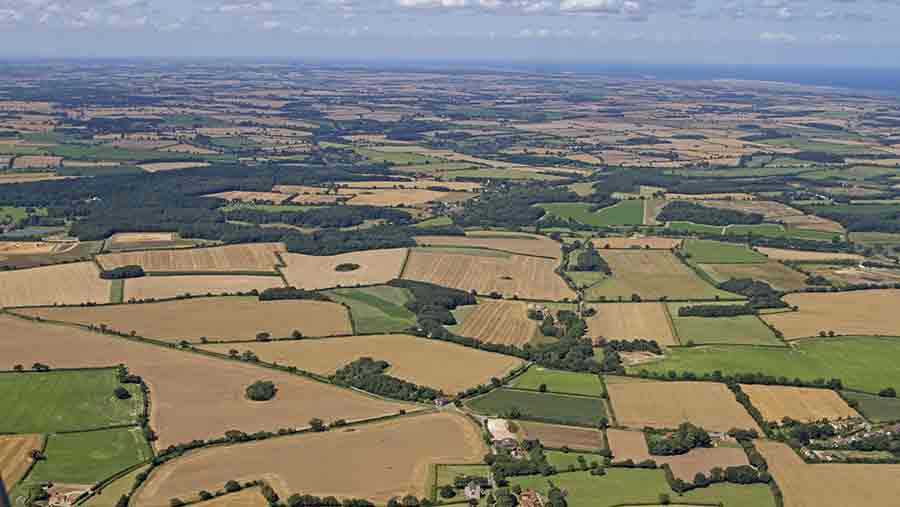Decline in land prices slows as supply dries up
 © FLPA / Roger Tidman/REX/Shutterstock
© FLPA / Roger Tidman/REX/Shutterstock Land prices are continuing to fall, but the decline has slowed on the back of a significant drop in supplies.
In the first quarter of 2017 the average value of bare farmland in England and Wales slipped 0.5% to £7,435/ acre, according to Knight Frank’s Farmland Index.
This was the smallest quarterly drop since arable prices started to fall in September 2015 and much less dramatic than the 8.5% drop recorded on the agent’s index last year.
This suggests the farmland market could be starting to stabilise, said Andrew Shirley, head of rural research at Knight Frank.
Supply issues
Supply of farmland across Britain in Q1 was 38% down on the long-term average and 42% down on the same quarter last year, according to Savills’ rural research team.
Just 11,000 acres were publically marketed across the country. Supplies were particularly thin on the ground in Wales, where just 100 acres were put up for sale compared to 2,000 acres in the first three months of 2016.
See also: UK must find a niche in competitive global crop markets
“The farmland market is generally weak in the first three months of the year and we have to be careful with percentage swings on low overall numbers,” said Ian Bailey, director of rural research at Savills.
“However, anecdotal evidence suggests that while so much political uncertainty remains this pattern will likely continue at least into the second quarter of 2017.”
He added that historically such uncertainty had reduced supplies, and pointed to the 2001 foot and mouth outbreak and 2004 just before single farm payments came in.
“Furthermore, the weak pound is possibly providing some respite on farm debt by increasing the value of subsidies and wheat prices, which may be holding off potential debt-related sales,” he said.
Large carryover of unsold land
However, Michael Fiddes, head of estates and farm agency at Strutt & Parker, said he expected supplies to “catch up” later in the year, given the number of farms that were known to be entering the market.
More than 40% of farms marketed last year were still on the market in December, but a “flurry of activity” since then had reduced the backlog, said Mr Fiddes.
Low supplies were “possibly due to some vendors delaying marketing to avoid the carryover from 2016 and due to more land than usual being marketed at the end of 2016”, he said.
Market still strong, but prices variable
Referring to the recent sales activity, Mr Fiddes said: “This is encouraging and suggests that buyers remain confident about land as a long-term investment, although it is now taking longer to get sales to the point of completion.”
Demand and prices are still highly variable, according to Strutt & Parker. Less than 40% of arable land was sold at £6-8,000/acre in Q1, with most selling at £10,000/ acre. Most posture land fetched £6-8,000/acre.
Land prices have increased 115% in the last decade and 4,402% in the last 50 years, according to Knight Frank.
What the land agents say

Andrew Shirley, Knight Frank
“Although most farmers have got their heads around the fact that by 2020 agricultural subsidies will be much diminished, it seems likely that more of them will decide to call it a day in the coming years.
“How quickly that happens will depend on how multiple factors, including commodity prices and interest rates, interact. An increase in borrowing costs coupled with low farmgate prices could force the hand of those struggling to make money without subsidies.
“The market will stand a limited increase in the number of farms for sale; in fact, prices could be higher for those that bring their units to the market early. But once interest rates eventually start to rise the pressure to sell will grow – more farms and land will come to the market and this will push down average farmland values.

Charles Dudgeon, Savills
“Negotiations around Brexit and a potential second referendum on Scottish independence will inevitably create some uncertainty [in the Scottish market] over the next few years and may lead to prolonged shortage of supply, which will continue to support land values.
“However, we expect value for money to be a more significant driver. The price differential is encouraging farmers from England to expand their farming enterprises north of the border and this is likely to continue.”

Michael Fiddes, Strutt & Parker
Mr Fiddes expects supplies to “catch up” later in the year, but, based on his knowledge of what is going to be marketed in the coming months, levels are unlikely to exceed those seen in recent years.
“This is likely to support prices, although undoubtedly a wide range in values will continue to be achieved dependent on location. Farms are generally taking longer to sell and most prices have eased back from the highs of 2015, but overall the market remains pretty resilient given the uncertainties associated with Brexit.”
